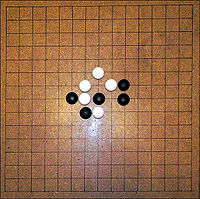


Renju is played on a 15x15 gridded board. The playing pieces, called stones, are played on the grid line intersections.
|
|
| Genre(s) | Board game Abstract strategy game |
|---|---|
| Players | 2 |
| Age range | 5+ |
| Playing time | Casual games: 5 to 30 minutes; tournament games: from 10 minutes (renju blitz) to 5 hours or longer |
| Random chance | None |
| Skill(s) required | Strategy, tactics |
Renju (Japanese: 連珠) is the professional variant of Gomoku, a strategy board game originating in Japan from the Heian period. It was named Renju by Japanese journalist Ruikou Kuroiwa (黒岩涙香) on December 6, 1899 in a Japanese newspaper Yorozu chouhou (萬朝報). The game is played with black and white stones on a 15x15 gridded Go board.
Renju eliminates the "Perfect Win" situation in Gomoku by adding special conditions for the first player (Black).
Unlike Gomoku, Renju has a unique sequence of opening moves called an "opening rule". There are several certified opening rules. The list of requirements for new opening rules as approved by the RIF General Assembly in 2003 was:
I. Traditions
II. Simplicity and attraction
III. Creativity
An example of such opening rule (namely "RIF opening rule") follows.
After this sequence is complete, Black and White continue to take turns to place their stones.
The Extra General Assembly of Renju International Federation in 2008 created three new sets of rules for openings that are to replace the above old sequence of moves: Soosõrv, Taraguchi, and Yamaguchi. Also a rejection system for their use was approved. The General Assembly of Renju International Federation in 2009 certified Sakata opening rule as proposed by Russia. The General Assembly of Renju International Federation in 2011 certified modified opening rules such as Taraguchi-N and Soosõrv-N.
There are certain moves that Black is not allowed to make:
Black can win the game only by placing five black stones in a row (vertically, horizontally or diagonally).
White can win by either:
World Championships in Renju have occurred every second year, since 1989. Since 2009 the opening rule being played is Yamaguchi.
Previous World Championships have taken place in the following places:
| Title year | Hosting city, country | Champion | Opening rule |
|---|---|---|---|
| 1989 | Kyoto |
Swap opening rule | |
| 1991 | Moscow USSR | Swap opening rule | |
| 1993 | Arjeplog |
Swap opening rule | |
| 1995 | Tallinn |
Swap opening rule | |
| 1997 | Saint Petersburg |
RIF opening rule | |
| 1999 | Beijing |
RIF opening rule | |
| 2001 | Kyoto |
RIF opening rule | |
| 2003 | Kyoto |
RIF opening rule | |
| 2005 | Tallinn |
RIF opening rule | |
| 2007 | Tyumen |
RIF opening rule | |
| 2009 | Pardubice |
Yamaguchi opening rule | |
| 2011 | Huskvarna |
Yamaguchi opening rule | |
| 2013 | Tallinn |
Yamaguchi opening rule | |
| 2015 | Suzdal |
Yamaguchi opening rule |
Team World Championships in Renju have occurred every second year, since 1996. Since 2010 the opening rule being played is Yamaguchi. The results are following.
| Title year | Hosting city, country | Champion team |
|---|---|---|
| 1996 | Saint-Petersburg |
|
| 2000 | Tallinn |
|
| 2002 | Vadstena |
|
| 2004 | Tyumen |
|
| 2006 | Tallinn |
|
| 2008 | Helsinki |
|
| 2010 | Tokyo |
|
| 2012 | Beijing |
|
| 2014 | Taipei |
World Championships in Renju via Correspondence were held in 1982, 1984, 1985 (by paper letters, later by e-mails) and now are played every year since 1996 with an exception in 2009, 2010. Since 2014 the opening rule being played is Soosõrv-7. The results follow.
| Title year | Champion | Country |
|---|---|---|
| 1982 | Sapronov, Vladimir | |
| 1984 | Nosovsky, Alexander | |
| 1985 | Nosovsky, Alexander | |
| 1996 | Reims, Aldis | |
| 1997 | Tarannikov, Yuri | |
| 1998 | Fedorkin, Oleg | |
| 1999 | Fedorkin, Oleg | |
| 2000 | Reims, Aldis | |
| 2001 | Nikonov, Konstantin | |
| 2002 | Lunkin, Vitaly | |
| 2003 | Chen Wei | |
| 2004 | Sun Chengmin | |
| 2005 | Barykin, Victor | |
| 2006 | No gold awarded | Silver: |
| 2007 | Epifanov, Dmitry | |
| 2008 | Zhang Jinyu | |
| 2011 | Balanova, Jelena | |
| 2012 | Potapov, Alexey | |
| 2013 | Sushkov, Vladimir | |
| 2014 | Sushkov, Vladimir |